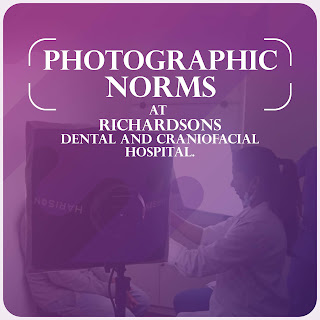Photographic norms at Richardsons Dental and Craniofacial Hospital.
Photographic norms at Richardsons Dental and Craniofacial Hospital.
WHAT IS THE IMPORTANCE OF PHOTOGRAPHY IN ORAL AND MAXILLOFACIAL SURGERY…???
Craniofacial surgery deals with a vast number of cases with various clinical appearances and complications. Clinical Photographs play an important role in diagnosing and planning in craniofacial surgery. A major aspect of clinical photographs is:
- Presenting a rough outline of surgery to the patient.
- Assessing the aftermath of the surgery.
- Documentation for medico-legal cases and medical records.
- For scientific publications and presentation purposes.
- Educating and inspiring the budding craniofacial surgeons.
PHOTOGRAPHY PROTOCOLS FOLLOWED IN RICHARDSON DENTAL AND CRANIOFACIAL HOSPITAL
It is mandatory to maintain consistency in patient clothing, background, angle of the camera, lightening and positioning the patient. Here at Richardsons, we have an individual studio room where the patients are photographed. Patients are photographed step by step from the first consultation to the last follow up, so as to evaluate the outcome and progression of the treatment provided.
Every patient is photographed and it is maintained in a segregated manner as preoperative (before the procedure is performed), Inter-operative (during the procedure), post-operative (after the procedure) and follow up pictures. These pictures are only accessible to the respective staffs alone, to keep up the confidentiality.
PRECAUTIONS BEFORE CLINICAL PHOTOGRAPHY
- Before taking pictures patient’s consent is taken.
- Explaining the purpose of clinical photography to the patient.
- Exposure of the face should be limited only up to the surgical site.
- Photographs and videos posted on our social site are done with the consent of the patient.
So when the patients come for follow up or years later, it will be a better tool to evaluate the esthetic outcome especially in the case of cleft lip and palate where the child is operated at 3rd and 10th month respectively and procedures like sub-acute alveolar bone graft, cosmetic procedures such as rhinoplasty, genioplasty, etc
Here at Richardsons, we have a professional photographer and videographer who keeps and maintains the record of the patient and our hospital is equipped with a high-quality camera and lighting setup so as to give the surgeon and patient a high-quality records we use a high profile canon mark ii camera and a harison light and also at Richardsons the quality is never compromised under any circumstances. Every record maintained has been shown and accessible to the patient on request.
So we have a specific position and angle to be maintained before the photos are being taken as mentioned above. Initially, the facial profile is assessed.
The position captured are,
- Front view
- Right side and left side view
- Chin up view
The same position is followed,
- Pre-operatively
- Postoperatively
- Follow up





Comments
Post a Comment